



Feature Story
More feature stories by year:
2024
2023
2022
2021
2020
2019
2018
2017
2016
2015
2014
2013
2012
2011
2010
2009
2008
2007
2006
2005
2004
2003
2002
2001
2000
1999
1998
Return to: 2009 Feature Stories
CLIENT: MACTEC, Inc.
May, 2009: Stormwater
As the first of a three-part series on stream restoration intended to realize the disparity between design and construction, and how this contributes to failure, this article provides the designer’s perspective on which challenges pose the greatest risk to the success of a stream restoration project.
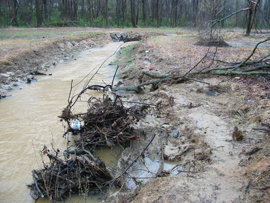
Photo: City of Charlotte
Figure 1. Storms caused bank failures along this small stream, Hope Park Branch.
Restoration may be defined as the return of natural function lost, usually resulting from associated watershed management such as development and agricultural practices. Depending on the number of lost functions restored, or the level of improvement, restoration may also take the simpler form of rehabilitation or stabilization. Restoration, rehabilitation, and stabilization of streams are performed for a variety of reasons. The primary driver for this type of work is the Clean Water Act (CWA). The objective of the CWA is “to restore and maintain the chemical, physical, and biological integrity of the nation’s waters,” and, for this reason, it prohibits the discharge of dredged or fill material into wetlands, streams, and other waters of the United States, unless a permit issued by the US Army Corps of Engineers or approved state under CWA Section 404 authorizes such a discharge.
Under the CWA, there are two major mechanisms that promote improved stream health: 1) Section 404 of the CWA, which provides for the use of compensatory mitigation to offset unavoidable damage to wetlands and other aquatic resources, and 2) the National Pollutant Discharge Elimination System (NPDES) stormwater permit program, which establishes requirements for municipal separate storm sewer system (MS4) nonpoint discharge. Permitted jurisdictions are sometimes prompted to perform watershed improvements, including stream and wetland restoration, as part of a larger strategy to implement total maximum daily loads (TMDLs).
Stability Versus Instability
Characteristic of most natural systems that reflect landscape conditions, stable streams exist in a state of dynamic equilibrium (Strahler 1957 and Hack 1960). This refers to an open system that, despite continuously receiving a varying inflow of discharge or sediment, maintains a stable hydraulic geometry (cross-sectional dimension, horizontal alignment [pattern], and vertical alignment [profile]) by transporting portions of this material within and beyond a mensurable reach. One fundamental axiom of stability is that the channel form is largely a function of the physics between discharge and the ability of a stream to move sediment, resulting in a equilibrium relationship, Qsds ~ QwS0 (Lane 1955), where Qs represents sediment quantity for a given discharge Qw, and where ds serves as the associated sediment size characterization (often the mean particle size, d50), and where S0 is the stream slope. If any of the four variables are changed, then changes to one or more of the other variables will occur to restore equilibrium. More simply, the channel form is a function of channel hydraulics, which in turn is a function of channel form.
Typically, restoration sites reflect the disequilibrium of a rapidly changing watershed, and active efforts to restore the channel form directly yield impacts (intentional or sometimes inadvertent) to the channel hydraulics and ability to transport sediment. This simplified relationship becomes more complicated when we attempt to account for the effect of vegetation. Regardless of attempts by engineers to accurately predict channel response following the construction phase of a restoration project, it is not unusual for the stream to experience unanticipated minor adjustments such as deposition on the inside of point bars or minor scour in areas of structure placement. The vulnerability of a restoration project is usually at its highest immediately following construction, and despite probability, that is usually when the stream will experience a major storm event and an increased likelihood of failure. Failures are often accompanied by cost overruns and adverse generalizations compounding the difficulty of advocacy.
A failure may be defined as the inability either to perform primary project objectives (i.e., bank stabilization, water-quality improvements, riparian and aquatic habitat enhancements) or to otherwise avoid creating additional impacts that result in unstable geometry attributable to one or more typical problems. Typical problems may include, but are not limited to, increasing velocity and/or shear stress resulting in excess competency and bank/bed scour; decreasing energy slope and channel depth resulting in reduced capacity and excess aggradation; and failure to account for multidimensional flow properties, such as lateral and vertical turbulence resulting in bank/bed armor structural instability. Failures may occur within an actively restored reach or throughout nearby upstream and downstream reaches, and they may take on a number of forms. While some failures may be immediately visible, others can take years to mature into potentially fatal conditions.
Why Failures Occur
Once a failure is recognized, the cause should be identified before attempting to correct the problem. This can often be a difficult process, as the designer and contractor have varying perspectives, and the client is pulled by strong arguments that attempt to divert fault. In many instances, the failure is a function of both the design and construction, and discerning accountability becomes a fruitless effort. Progress toward resolution begins only after the all parties involved come to realize the benefit of collaborative problem solving.
Design Errors
Design failures may occur at any point during a project process, from poor selection of a treatment site to poor design philosophy/methodology, incomplete construction documents, and weak implementation.
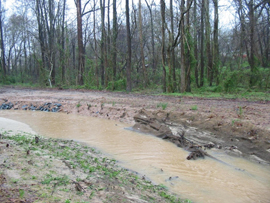
Figure 2. Before restoration, jute matting served as the only bank protection.
Beyond site selection, common stream restoration design failures include those associated with the quality of design documents. Acting in concert with stormwater interests, the stream mitigation elements of the Clean Water Act have stimulated the science and permitting industry, resulting in non-engineered design. While in many states, the application of engineering principles (hydrology, hydraulics, fluid/soil mechanics, surveying, etc.) is reserved for the licensed professional engineer, other states have allowed these practices to occur unregulated. Some design failures are attributable to the learning environment of this “emerging science” and attempts to stretch application in the interest of gaining knowledge. While this may be valuable to the industry, it may not always meet the need or budget of the municipal client. It should be noted that because of the complexity of working with dynamic systems driven by unregulated forces, a qualified design team incorporates various expertise, including those with foundations in science, engineering, and public policy. However, the actual design and accountability of proposing large-scale earthwork (plans, specifications, contract documents, etc.) should lie on the shoulders of the licensed engineer. Because of this “pioneering” nature of stream restoration, inconsistencies in design and individual designer standards have yielded mixed results when applied to conventional construction settings.
Professional accreditation aside, erroneous design philosophy also contributes to design failures through poor applications based on inaccurate assumptions and/or failure to incorporate adequate design criteria (i.e., consideration of a small range of discharge events). Consideration of a single index flow (bankfull discharge) may be appropriate for the design of a first-order stream impacted by historic agricultural and silvicultural activities, but it is important to note that stable channel morphology is actually a function of a wider range of flows. For the more complex urban condition, a natural channel design approach (Rosgen 1994) serves as a good starting point for the desired range of conditions, but further consideration of process reveals that the combined flow and sediment regime have permanently been altered, and a reference condition for a natural system may not apply well. The key in these situations is to realize the tendency of the natural system (when subjected to such wide-scale watershed disturbance), understand the departure from stability associated with the existing condition, and predict the ultimate watershed conditions and corresponding stable stream process. This is often accomplished by amending a natural channel design approach with additional analytical tools, such as sediment transport modeling, stability calculations, and hydraulic modeling for a range of flows spanning from base flow to flooding events of low recurrence. Consideration of the process associated with a range of flows allows the engineer to develop a more thorough knowledge and to make practical design adjustments to prevent failure that may otherwise be overlooked.
Construction Errors
On occasion, the contractor’s lack of conventional and innovative knowledge (including the basic understanding of physical processes), equipment, and/or skills may cause the engineer and the client to conclude that a contractor is inexperienced or simply does not know what he or she is doing. Left unattended, this situation almost surely leads to the failure to construct a restoration project per design plans, ultimately resulting in project failure. This situation can be avoided or minimized by incorporating adequate prequalifications into the contract documents, providing for construction assistance by qualified engineering technicians, and utilizing contract mechanisms (such as stop work and the threat of taking bond) to prevent the situation from reeling out of control.
Because the actual construction of a project usually is a function of various factors that precede the contractor’s involvement (site selection, earthwork/structural design elements, design documents, etc.), it is both difficult and unfair to place construction errors directly on the shoulders of the contractor. It is always a good idea to coordinate elements of the design (types of bank or in-stream treatments, sequence of construction, staging and access, and erosion and sediment control) with client contractors regarding constructability and value engineering. This prevents extreme changes (addendum, redline, or otherwise) to the plans and unforeseen cost and schedule burdens.
In the case of low-bid contracting, errors related to lack of basic knowledge can be addressed through mandatory pre-bid meetings where project expectations can be clearly identified through an engineering presentation. Prequalifying contractors or soliciting bids by invitation only may prevent anomalous bids that skew the client’s perceived project cost. Occasionally, certain attempts at saving money end up costing more in dollars, resources, and/or schedule. Providing “good versus poor” examples to establish common expectations always results in a tighter range of bids more reflective of the costs and prevents the exceptionally low underbid. This type of information-sharing helps the contractors bid effectively and prevents miscommunication of the design intent inferred through the contract documents. A similar, but more technical, training presentation by the engineers to the awarded contractor operators on how to best accomplish the design intent, detailing the specified materials and methods of construction, can prevent false starts and impacts to budgets and schedules. Because good contractors are smart and know exactly what their operators, crews, and equipment are capable of, this communication milestone may also serve as an opportunity to value-engineer the proposed restoration project above and beyond that performed during design. This two-way dialogue allows the contractor/engineer/client team to establish communication protocols before the construction commences. In addition to providing comprehensive and well-composed contract documents, another tool to reduce low-bid construction failures is to incorporate a time-and-material method of payment that relieves the contractor of concerns about overages and allows the contractor to perform work (or a portion thereof) under the “direction” of the engineer.
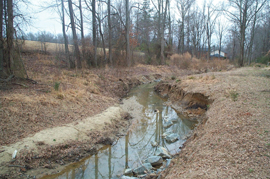
Photo: City of Charlotte
Figure 3. Both reaches of Hope Park Branch experienced failures.
Addressing a Failure
Because failures are to some degree unavoidable, the method and means by which we prevent and address failures is just as important as evading failures completely. The effectiveness of any solution is only as good as the problem assessment. While some potential failures may be better understood if left alone and observed over the short term, other problems pose a greater risk and require immediate attention. Once a fatal flaw is recognized, it is usually not financially practical to correct the fundamental problem. In this case, the fundamental problem is not the isolated failures, but rather, the overall failure of the design or the failure in construction. If the project is constructed in strict accordance with the design documents and field changes occurring only under the approval of the engineer, it is usually very difficult to place the entire burden of failure on the contractor. Once the failure is identified, the entire team must work collectively to resolve the matter, maintaining the client’s interest in cost. Well-written technical specifications (provided by the engineer) that present explicit guidance on the process and authority to approve field changes can facilitate resolution in a situation such as this. It is important to consider the value of timely resolution based on clear preferences versus the additional cost of remaining in a holding pattern indefinitely while communication dwindles.
Obvious to most, failure prevention measures are worth tenfold their cost. In addition to incorporating a scrutinous level of detail in the contract documents, other strategies may be considered. The potential for contractor rework or additional work must be accounted for in the design of the access, staging, and sequence of work. This minimizes additional site disturbances and costs and helps remediate the failure. In addition, a cost contingency—often between 5% and 25%, depending on the design assumptions—should be incorporated into the overall project budget. Although this may not cover the cost altogether, it will maintain project momentum, allow for timely response to failure, and occasionally prevent incurring unnecessary demobilization/remobilization costs. Effectively anticipating problems in the field and addressing them with timely communication is usually accomplished through frequent site inspections by the engineer or another qualified client representative. Sometimes the client may perceive this level of involvement as excess project cost burden, but its value is better understood only after construction problems escalate to being serious.
Case Studies
The city of Charlotte, NC, has been in the business of water-quality improvement since 1993 through the work of its Storm Water Services Division. Performing projects either as part of the Umbrella Mitigation Bank or under other initiatives of the water-quality-improvement program, Storm Water Services has completed tens of thousands of feet of stream restoration and enhancement. Before the Umbrella Mitigation Bank was established in 2004, stream improvement efforts focused mostly on streambank stabilization to reduce sediment loads in local streams. Since that time, the stream restoration program has evolved to become responsive to changes in the industry and adaptive to the urban watersheds within which the program is constrained.
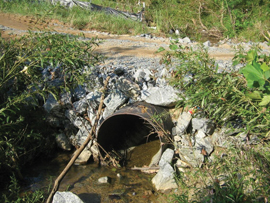
Photo: City of Charlotte
Figure 4. A portion of the stream buffer was cleared for access during sewer line maintenance.
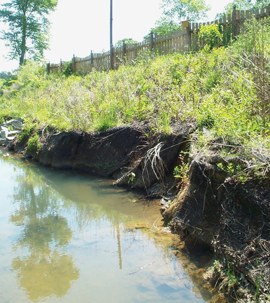
Photo: City of Charlotte
Figure 5. Bankfull benches were constructed too stream to become entrenched

Photo: City of Charlotte
Figure 6. To prevent erosion, additional energy dissipation was needed.
The city’s Umbrella Mitigation Bank was the first municipal mitigation bank in North Carolina and the only mitigation bank to work entirely within urban watersheds. As an early pioneer of urban stream restoration, Storm Water Services has encountered its share of problems. Not only were the projects technically challenging, but also project managers, construction managers, and inspectors had to overcome administrative challenges that were not typically found on flood control or stream stabilization projects. Stream designers had little experience working in urban watersheds, and construction firms that bid on the work were not skilled in the art and science of stream restoration. These challenges led to failures on some of the early projects constructed by Storm Water Services; two such projects, Hope Park Branch (completed in the spring of 2003) and Edwards Branch (completed in the fall of 2004), have been selected as case studies to highlight some of these issues. Both projects are located within Charlotte city limits.
Hope Park Branch Stream Restoration. Hope Park Branch is a small stream within the Briar Creek sub-basin of the lower Catawba River. The project is bisected by a major thoroughfare roadway, creating two reaches on land owned primarily by Mecklenburg County Park and Recreation and Charlotte-Mecklenburg Schools. The watershed is entirely built-out, with small single-family lots, large multifamily housing units, commercial facilities, two small parks, and two school sites contributing drainage. This creates a flashy hydrograph that leads to high shear stress for a short duration during the typical Charlotte thunderstorm.
Hope Park Branch was the first major stream restoration project completed by Storm Water Services, and the problems encountered have been the result of both inexperience and bad luck. Immediately following construction, the project was hit by several large storms before the riparian vegetation had a chance to take root. With a heavy jute matting serving as the only bank protection, the storms caused bank and structure failures along both reaches of the project (Figures 1 through 3). Upon closer examination, it was discovered that several field design changes were made during construction, resulting in a channel that was too deep and structures that were built improperly. Through several major reconstruction efforts, these issues have been corrected, but the cost of repairs nearly doubled the original project estimate.
Hope Park Branch is considered a “reach restoration,” meaning it is a small reach that is restored within a larger contributing watershed. The downside of restoring only a reach within a larger watershed is that the project owner does not have control over activities that take place upstream of the restored reach. This has been problematic for Hope Park Branch, as the upstream sediment supply is being sequestered within the restored channel and on the floodplain benches. This has caused the banks to build and the stream to become slightly entrenched, thereby limiting floodplain access and reducing storage. The contributing watershed is now being re-evaluated for stabilization opportunities to reduce the sediment load reaching Hope Park Branch.
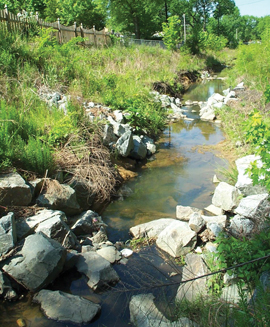
Figure 7: The lower section of Edwards Branch
Edwards Branch Watershed Improvement Project. Edwards Branch is a medium-sized stream, also within the Briar Creek sub-basin of the lower Catawba River. Like Hope Park Branch, the watershed is entirely built-out, with small single-family lots, several large multifamily housing units, several large commercial sites, a park, a cemetery, and a school site contributing drainage. Two tributaries enter the main stem of Edwards Branch, and restoration activities have taken place throughout the watershed. In addition to stream restoration, project features include two constructed wetlands, one wet pond, a dry extended detention basin, and buffer enhancements.
Issues encountered on this project are similar to those encountered on Hope Park Branch. Bankfull benches were constructed too high, causing the stream to become entrenched (Figure 5). Structures were modified or eliminated from the plans, lowering the energy dissipation capacity of the new channel. Property owners and park maintenance crews mowed the buffer in several areas, causing localized bank failures. Invasive species encroachment threatens the survival of the planted vegetation, and poor soils have caused some areas to remain sparsely vegetated.
One notable difference between Hope Park Branch and Edwards Branch relates to sediment. Whereas Hope Park Branch is sediment laden, Edwards Branch is sediment starved as a result of the stabilization of streambanks throughout the watershed. Because this “hungry” stream no longer performs the work of carrying a high sediment load, additional energy dissipation was necessary to prevent erosion of streambanks and around structures (Figures 5 and 6). Field design changes and elimination of structures during construction caused failures in the lower section of Edwards Branch (Figure 7), and a major reconstruction effort has recently been completed to correct these issues.
Storm Water Services has learned many lessons through the construction of these and other projects, and numerous processes have been implemented to reduce the likelihood of failures in the future. Project managers, construction managers, and inspectors receive training so that they understand the details of the projects they are managing, and design consultants are held responsible for their designs. Although the construction contracts are still awarded to the lowest bidder, all contractors must prequalify in order to bid. Storm Water Services conducts follow-up inspections of the projects after each major storm event, and any failures or areas of concern are addressed before they become problematic. Several on-call services contracts allow repairs to be completed in a timely manner, leaving time for plant installation. Annual communications with property owners have reduced the number of easement violations along restored reaches, and easements have been strengthened to ensure protection of the buffer in perpetuity. Invasive species are controlled annually, and willing property owners receive training on how to identify and remove invasive species in their easements. While these policies and processes may not prevent a case of bad luck, they go a long way in improving the quality of future stream restoration projects.
Closing Thoughts
From the designer’s standpoint, the structure of the project team is largely a function of the design documents and resultant bid. As a responsible consultant, promoting client awareness on the process of “doing” the work is just as important as promoting awareness on technical elements, but it may often have more resounding implications. In the interest of the client, prequalifying the design engineering consultant may actually be the best first step to engaging in a restoration project and preventing a compounded learning curve.
Return to: 2009 Feature Stories